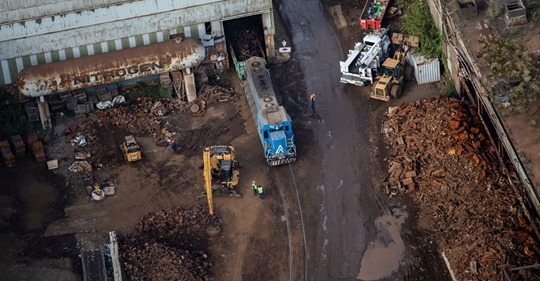On a sweltering morning at the Altgeld Gardens public housing complex, Patrice Black and Lashanda Smith look at each other and nod. Yes, the “toxic donut,” that’s their Southeast Side neighborhood’s nickname.
A large landfill bounds Altgeld Gardens on one side, a sprawling sewage treatment plant on another. Not far away, the Little Calumet River “stinks before you even come up on it,” Smith says. Elsewhere on the Southeast Side, more landfills, a host of industrial plants, and two sites on the federal Superfund list of abandoned, highly contaminated industrial tracts.
New neighbor: General Iron
Now the people of the Southeast Side find themselves braced for another polluter. General Iron Industries plans to move from its Lincoln Park site along the North Branch of the Chicago River to a largely Hispanic Southeast Side neighborhood known as the East Side. Mayor Lori Lightfoot worked out a deal that ensures the company’s North Side plant leaves Lincoln Park by the end of this year.
In July 2018, the U.S. Environmental Protection Agency cited General Iron for failing to contain lung-damaging particulate matter within the company’s property, and accused the firm of failing to reduce emissions of harmful chemicals. This year, city health inspectors ticketed General Iron 11 times over a five-month span after receiving complaints of “untreated emissions” coming from the company’s scrap shredders.
But residents of the Southeast Side once again ask a valid question. Why are we the city’s trash bin for waste and pollution?
“I don’t think it’s right that they will bring this out here,” Black, 58, and a resident of Altgeld Gardens for 16 years, tells us. “I know it will create jobs, but if it’s going to create something that’s going to kill our people, we don’t need it out here. Take it to a place where there are no kids or houses close by. We already have enough going on out here.”
The life expectancy gap
Lightfoot’s team is well aware of the burden that pollution puts onto the Southeast Side. A city report released earlier this year found that, when it comes to air pollution, the areas hardest hit are predominantly Black and Hispanic neighborhoods on the South and West sides:
“Chronic disease is the leading driver of Chicago’s nine-year life expectancy gap between Black and white residents, and decreases in life expectancy in the Latinx population,” the report states. “Air pollution can both increase risk of chronic illnesses like heart and lung diseases and contribute to worse outcomes for people living with certain health conditions. We must ensure that our environmental policies are focused on communities where residents are at highest risk.”
The first place Lightfoot should direct that focus is the Southeast Side. General Iron has promised to make its East Side operation the country’s cleanest metal-shredding facility. “No other recycling business in the Chicago area has the capacity or pollution control equipment to handle the massive volume of metal shredding and recycling that the area demands,” the company states on its website.
There’s no doubting the need to keep scrap metal from piling up in landfills and city alleys. And, as General Iron says, the plant’s opening will bring more than 100 new jobs to the Southeast Side.
‘Glitzy glass and steel’ — for North Side
All right, but does every economic shot in the arm delivered to the Southeast Side have to come with the prospect of more pollution? It’s not lost on Southeast Siders that General Iron is leaving Lincoln Park at a time when the tony North Side neighborhood is on the cusp of a development supernova, in the form of the multibillion dollar Lincoln Yards project, estimated to yield 23,000 new jobs and a yearly economic output of $4.5 billion. As we said in 2018 after General Iron announced its plans for the Southeast Side: “The North Side gets glitzy glass and steel — and the South Side gets the scraps.”
Editorials reflect the opinion of the Chicago Tribune Editorial Board.
Get our latest editorials, commentaries and columns delivered twice a week in our Fighting Words newsletter. Sign up here.
Join the discussion on Twitter @chitribopinions and on Facebook.
Submit a letter, of no more than 400 words, to the editor here or email [email protected].
On a sweltering morning at the Altgeld Gardens public housing complex, Patrice Black and Lashanda Smith look at each other and nod. Yes, the “toxic donut,” that’s their Southeast Side neighborhood’s nickname.
A large landfill bounds Altgeld Gardens on one side, a sprawling sewage treatment plant on another. Not far away, the Little Calumet River “stinks







